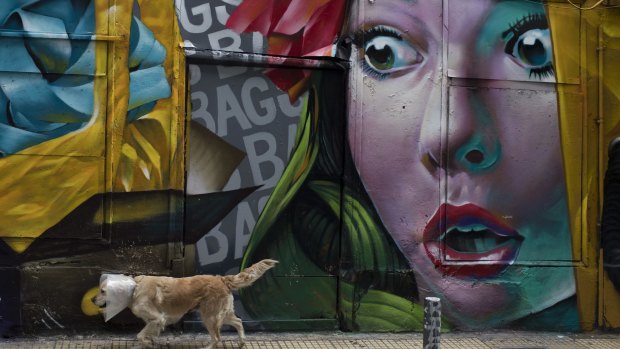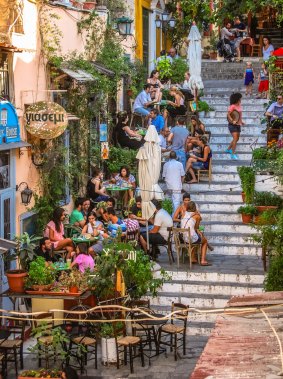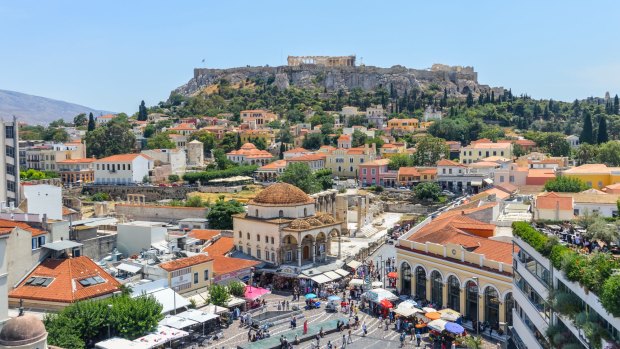This was published 4 years ago
North of Athens' touristy Plaka, a vibrant neighbourhood offers local flavour
By Steve McKenna

The humming district of Psiri (or Psyri).
Like all the great tourist sites, the Acropolis of Athens is almost impossible to resist. Visiting the Greek capital, especially for the first time, you'll be drawn to climb this rocky outcrop, braving the crowds for photos by the ruins of the Parthenon and magnificent views over Athens, its dazzling urban sprawl dramatically squeezed between mountains and sea.
But just as engaging, and far more enjoyable, is getting lost in the maze of serpentine streets and squares that fan out from the foot of the Acropolis. Having spent the morning with our guide, Sophia – who'd entertained us with stories of ancient Athens, the goddess Athena and the roots of democracy – we're free to spread our wings and absorb modern-day Athens, a metropolis that's on the rise again after a decade of political and economic turmoil.
It's my first trip back to Greece since the start of "the crisis", the moniker Greeks use to describe the tumultuous years of emergency bail-outs, drastic government cuts and austerity measures, street protests and riots. While the economy has stabilised, scars remain, with high unemployment (40 per cent for under-25s), hard-hit public services and a significant brain drain (it's thought up to 400,000 Greeks, many well-educated and in their 20s and 30s, fled their homeland after 2010, mostly to other European Union nations).

Al fresco dining in Athens' Plaka district.Credit: iStock
Despite this, Athens is as sun-soaked, noisy, lively and life-affirming as I remember it, perhaps more so, and tourism plays a major role. Last year Greece's annual visitor numbers topped 33 million, up from 18 million in 2008, and more and more travellers are beginning their Greek odyssey in Athens, providing a boost in jobs and investment and sparking a wave of new openings in the hospitality industry, from luxury hotels and swanky restaurants to hip bars and galleries.
Plaka, the city's oldest continuously inhabited neighbourhood (people lived here more than 3000 years ago), is tourist central. Vendors hawk pistachios and other roasted nuts from carts and loquacious proprietors try to entice you into their gift stores, cafes and gyros and souvlaki joints. Groups of friends and families, from China and Korea, Brazil and USA, and dozens of other countries, take selfies with the Acropolis in the background and queues snake into the shiny €130 million Acropolis Museum, which this year marks its 10th birthday and captivates archaeological buffs with discoveries from the old citadel and its slopes.
I find more of a "local" vibe – and hear more Greek chatter – north of Plaka in the pedestrian thoroughfares and backstreets wedged between three of Athens' main squares (Syntagma, Omonoia and Monastiraki). Although the recession froze wages and slashed pensions – the average monthly salary, about €800 ($1300), has barely changed in a decade – Athenians' love of shopping and socialising remains undimmed.

Monastiraki, a flea market neighbourhood in the old town of Athens.Credit: iStock
On bustling Ermou Street, which is lined with multi-national brands, I pass arm-in-arm mums and daughters, gangs of girlfriends, and fashion-conscious blokes carrying heaving bags and conveying a joie de vivre generated by a new dress or pair of shoes. By the Kapnikarea, a photogenic 11th-century Byzantine church, tattooed teens and twentysomethings break-dance to hip-hop pumping out of their speakers.
In the quieter, neighbouring alleys, arcades and passageways, there are cuter boutiques and funky concept stores selling everything from offbeat fashions and leather sandals to pottery and paintings. A variety of establishments tempt you with refreshments: French bistros and sushi bars, traditional tavernas and kafeneion (coffeehouses). Shaded by awnings, palm trees and plants, their front terraces teem with millennials mingling (and scrolling on their smartphones), young parents with boisterous children and pensioners chewing the fat, smoking cigarettes and watching the world go by.
The conversations almost drown out the distant sound of scooters and car engines.Wherever you go, there's street art. It smothers apartment walls, crumbling buildings waiting in vain for restoration, utility boxes and shop shutters. Besides the many ugly and unintelligible graffiti tags, there are wonderfully crafted and colourful murals (think modern twists on ancient Greek mythology and satirical swipes at contemporary culture and politics). It's said "the crisis" really got Athenians' creative juices flowing and you can delve deeper into this subject on street art-themed tours.
After a flat white jolt at Peek-A-Bloom, a cool cafe-roastery-cum-cocktail bar off Lekka Street, I meet up with Sophia and my group for a culinary tour of Athens. Cue the best part of four hours' grazing, drinking Greek wine and ouzo-like tipples and learning about the country's gastronomy and how it's been influenced by occupiers, including Romans, Venetians, Arabs and Turks.
Down the side of the covered central municipal market – where Athenians have come to stock up on meat and fish, fruit and vegetables, herbs and spices and the like since the 19th century – we duck into a deli that's been in the same family since 1974, when democracy returned to Greece after a seven-year military dictatorship.
Slabs of ham, giant curled-up soutzouki (spicy sausages) and garlands of garlic dangle from the deli's ceiling and we tuck into a spread of appetisers: plump olives, cheeses such as feta and Greek gruyere, and cured meats, including camel meat infused with spices (we're told this was a delicacy introduced to Greece by Armenian immigrants). As we sip our wine, Sophia reveals that the ancient Greeks would often add water to their wine so they could prolong their philosophical conversations and still talk sense.
Our group doesn't follow suit - the wine, red and white, continues to flow at full strength as the evening rolls on. At our next stop, Aiolou 68, a sleek new Mykonos-inspired seafood restaurant run by three young friends, we enjoy octopus salad and grilled fish. Then with the sun setting, we move deeper into Psiri (or Psyri), a district famed for its nightlife and are led into the seductively-lit "secret garden" of Oinopoleion, a rustic, old-school wine-taverna established in 1928. More carafes are delivered to our tables along with plates of fried meatballs, a dish of stuffed pasta with eggplant, cream cheese, tomato sauce and feta and a luscious yoghurt dessert drizzled with grated sweet carrot.
We're a merry bunch when we leave – or stumble out of – the taverna. The mild late-September air is spiked with the tunes of musicians strumming guitars and bouzoukis, and as we stroll there's much jollity from tourists and Athenians, young and old, wining and dining alfresco. And making our already good mood even better is the sight of the Acropolis, looming in the distance, beautifully lit up, an eternal presence in this enduring, effervescent city.
FIVE MORE THINGS TO DO IN ATHENS
STAVROS NIARCHOS FOUNDATION CULTURAL CENTRE
Funded by the estate of a late Greek shipping tycoon, this Renzo Piano-designed temple of contemporary culture sits in a new landscaped park in the Kallithea district, south of the city. It houses a library, exhibitions, theatre and opera. See snfcc.org
NATIONAL ARCHAEOLOGICAL MUSEUM
Often overlooked by tourists flocking to the new Acropolis Museum, this imposing neoclassical landmark displays more than 11,000 antiquities sourced from across Greece. It's in the edgy, artsy neighbourhood of Exarchia. See namuseum.gr
TAKE A HIKE
For the ultimate panorama of Athens, including a great shot of the Acropolis, scale Mount Lycabettus (277 metres), the tallest of the city's seven hills. The quickest option is by cable car, but there's a zig-zagging trail up that takes walkers of reasonable fitness about half-an-hour. Enjoy food, drink and more views from the terrace of the hill's Orizontes restaurant. See orizonteslycabettus.gr
ODEON OF HERODES ATTICUS
Dating back to AD161, this restored open-air theatre clings to the Acropolis' south-west slope and pulls in crowds with comedy, music and drama. Frank Sinatra and Luciano Pavarotti have appeared in the past, and performers in 2019 have included John Cleese and Nigel Kennedy. See whyathens.com
ATHENIAN RIVIERA
Go for a drive along this 48 kilometre-long stretch of coastline, south of Athens. Also dubbed the Apollo Coast, it promises dreamy vistas of the Aegean Sea and characterful beach towns and stylish resorts such as Glyfada. See visitgreece.gr
TRIP NOTES
MORE
TOUR
Athens is the start and end point for Collette's 14-day Exploring Greece and Its Islands. The tour is priced from $A4714 a person, based on two sharing, and includes sites such as Olympia and Delphi, the monasteries of Meteora and Mykonos and Santorini. The Athens culinary tour is optional and costs an additional $US99. See gocollette.com
Steve McKenna was a guest of Collette.
Sign up for the Traveller Deals newsletter
Get exclusive travel deals delivered straight to your inbox. Sign up now.